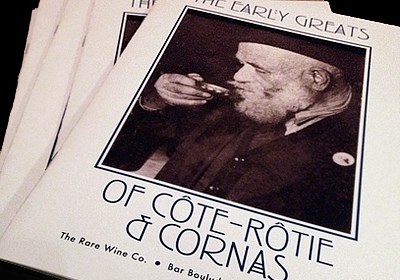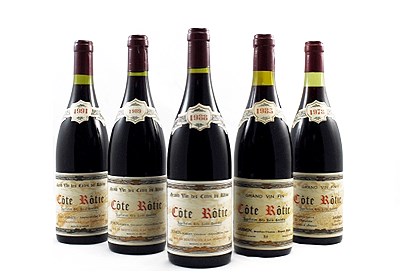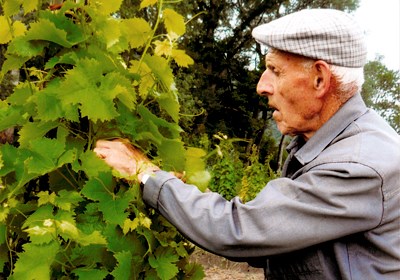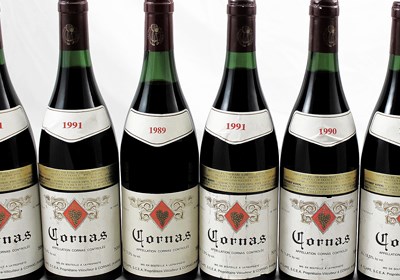
Which site would you like to visit?
By clicking the retail or wholesale site button and/or using rarewineco.com you are choosing to accept our use of cookies to provide you the best possible web experience.

August 26, 2013
For the past half century, the Jamet family has been one of the great growers in Côte Rôtie—one of the few producers remaining to still adhere to such important traditional practices as whole-cluster fermentation and the blending of sites (lieux-dits) to produce just one Côte Rôtie.
On April 8, 2013, we visited the Jamet cellars, to talk with current winemaker Jean-Paul Jamet about his philosophy of winemaking. We began our conversation while tasting one of his 2011 Côte Rôtie lieux-dits from barrel. As Jean-Paul makes but one Côte Rôtie in each vintage, this barrel will not be bottled alone, but will become one of the components as he creates the final blend.
Jean-Paul Jamet: This barrel sample is big in style, but still it’s very charming and the aromatic tension is great, isn’t it? And behind it, the wine continues onward. There’s real depth. In 2011, 100% of the wines were fermented in whole clusters because we had such great ripeness of the grapes and the stems. Using all the clusters and stems will re-equilibriate and give the wine a freshness, a depth in the mouth that wouldn’t exist if we had de-stemmed at harvest.
And so, for a vintages like 2011 and 2009, which had a huge amount of ripeness, it helps us compensate for the “generous” weather. In certain appellations farther south [like Chateauneuf du Pape] they’re now having to question their practices of de-stemming and high alcohol. My wines in 2009 are barely 13% alcohol.
RWC: Really?
JPJ: This is because I didn’t de-stem. If I had de-stemmed, I would have had 13.5% or 13.8% alcohol. In fact, I only de-stemmed one cuvée—it was the first cuvée harvested—and it was 13.8% alcohol. And so you can now see the effect of keeping stems.
There is something that you really have to understand about Côte Rôtie. The sugars climb as harvest nears, and then they practically plateau. When you get there [makes a plateau gesture] many winemakers think, okay, that’s the top, that's the maximum, we’re going to harvest here, and they do.
But after this climb, the sugar levels remain practically horizontal, and you can wait a very long time to harvest. As you wait, the quality of the tannins and the equilibrium get better. So we can be at 13.5%, and still we can wait. You can harvest later, with no more alcohol.
Then we talked with Jean-Paul about his philosophy of blending “different expressions of terroir of Côte Rôtie.”
JPJ: I’m of the mind and logic of someone like [Gerard] Chave, who also works with an assemblage of many different terroirs rather than making small single vineyard cuvées. With single-vineyard cuvées, very good wine is possible, but where there are strong and weak points to each cuvée. I’m already thinking about the assemblage when I start vinifying the first wines. I'm saying to myself: I’ve got these parcels harvested and these parcels still remaining, and I’m already starting to have an idea about the vintage and the winemaking in the first three weeks. If my idea is that the vintage will be powerful, I need to re-equilibrate [towards balance]. And if I’ve got a really elegant vintage like I did in 2011, for the last cuvée I tasted I was searching for the maximum extraction possible to tighten it up. In 2009, things were too generous, a little bit too “sunny” in character, and I told myself it would be interesting to work not only with the stems but with a longer maceration—something I normally don’t like to do. But in this case, it was helpful in tightening up the wine and it really worked.
RWC: Is that, for you, the art of being a winemaker, to use blending to find that equilibrium? As you know, there are a lot of winemakers around here making single vineyard cuvées. It’s a choice, right?
JPJ: We need to remember that in certain vintages, you can make some really magical single vineyard cuvées. I’m in total agreement about this. And you'll see, in tasting the rest of the 2011s from barrel, that each terroir or cuvée has its own identity. All the wines are expressing themselves beautifully, and there’s balance in each Individual cuvée. However, in assembling all these beautiful cuvées, the resulting wine is even better!
RWC: You anticipated my next question!
JPJ: My conception is that there’s a complementary nature between all the different expressions of the terroir of Côte Rôtie. And to be starting with this diversity of parcels, I think, comforts me because each terroir has an identity. But you also have to take advantage of it, and channel it, so that you're perfectly integrating these identities in the assemblage. It’s not like “oh, I have all these great terroirs and I’m just going to mix them all together.”
RWC: Is this an idea that you and your father (Joseph) shared or is this more of your own thinking?
JPJ: When my father and I started together in 1976 to estate bottle, really quickly it became me making the wine. My father was there, of course. But then, really quickly it was me making the choices.
RWC: And you were how old at that time?
JPJ: I didn't go to school for it, so I started working at 16. And it was good luck that I didn’t learn oenology; I learned history. By not going to [oenology] school, empirical and ancestral things were passed on to me. I was able to listen and see why things were done a certain way. I learned: why search for a complicated solution when you can do it simply? Why add yeast when the grape yeasts work perfectly well? Why add products that you don’t have any need to add? And why use new wood?
There was a time when we bought new barrels, but it wasn’t because my father thought that it was good for the wine. It was because we didn't have any barrels and we needed them to make wine. So, he started with second-hand barrels and then sure, some new demi-muids, but it wasn’t done for any reason.
RWC: Was your grandfather a vigneron?
JPJ: Everyone searches for their roots, and everyone has a history. But I prefer to look forward and not backward. That’s not in direct response to your question, but I've tried too many wines, where on the label it’s written, “Vignerons, Father and Sons, for 15 Generations,” and when you taste the wine, you say well ... the wine could be better. And so both of my grandfathers were vignerons; my maternal grandfather was very much a winemaker, he survived only by selling grapes; and my paternal grandfather had vines. And before them, everyone here had vines.
I had great-grandparents, great-great-grandparents, and so on, but there wasn’t much transmission between generations. We're not in Burgundy or Bordeaux. I'm saying this because Côte Rôtie after phylloxera in the 1870s had no more vines. On these steep hills, the vines weren’t able to be replanted, and that was a catastrophe. And then after 1929 [the Great Depression], selling wine was impossible. Vignerons worked on the plains where it was easier, because to make a Côte Rôtie to sell it at the same price as vin de pays d’oc [one of the most general French classifications of wine] was not of any interest. So, the appellation practically disappeared. By the 1940s, around the time the appellation was created, there were maybe at most 25 hectares of Côte Rôtie.
And, so, who saved Côte Rôtie? Who permitted the continued existence of the appellation? It was the negociant Vidal-Fleury. Despite financial loss, they supported the image of Côte-Rôtie.
Côte Rôtie was redeveloped after World War II, but it took a very long time. In the 1950s, there were some winemakers like the Chambeyrons; there was Antoine Chambeyron, Marius Chambeyron, and [Albert] Dervieux, [Robert] Jasmin, a little bit of Barge, Gentaz, and some folks that don’t exist today. So, there were only only a few vignerons and they made only a few hundred bottles.
Before, I was speaking about my maternal grandfather. I never knew him, so he couldn’t have transferred anything to me, and his vines had disappeared. So, what does it mean for me to say that my great-great-great-grandfather was a winemaker? I don’t know. But I do know we don’t have history like Burgundy, that has always had wine, and in Bordeaux where there were always Chateaux.
It was easier in Hermitage because the slopes were a bit less steep, and so I'm going to tell you something I think is interesting. Back in the day, the Bordelaise bought wine in order to ‘Hermitage’ their wine. The market the Hermitage producers found was perhaps not a great one, but they knew that it could help them. As for the Bordelaise, you know that if they were putting Hermitage in Bordeaux, it wasn’t to dilute it! I have a winemaker friend in Saint-Emilion who says that's why all the Bordeaux from the 30s, 40s, and 50s are still good, because it had Syrah.
I started from the beginning because my grandparents didn’t teach me anything and because my father learned at the same time as me. He said to me, “Now, do what you think is right.” I heard a little bit from some of the ancients. I heard from Gentaz, though I didn’t understand everything. Gentaz’s Côte Rôtie is our reference of finesse and elegance because his grandfather was a winemaker. So, he had a head start, if a very little one.
RWC: And so it was you or your father who decided to make your own wine?
JPJ: It was my father.
RWC: You were only 16 at the time, did you have a conversation about it? Did he say to you, this is going to be hard and I need some help?
JPJ: No, it was one of those things that just naturally decided itself. My father grew and sold grapes, and it was natural for him to say, “I’m going to put more effort into the work of growing grapes, and that will bring more value to the product.” But, he just had a couple of barrels! Little by little it grew. Everything just evolved, in a very natural way, and I have no memories of any debate. It was simply evident that in order to continue working the vines, the product needed to have greater value.
And to do that, it wasn’t by selling grapes in bulk, because a kilo of grapes had the same value as a kilo of cherries. In fact, at that time there was more interest in growing cherries than grapes on the hills, because a small plot of cherries paid better than a big plot of grapes. So, his only choice was to make wine and sell it himself.
RWC: Who did you sell grapes to?
JPJ: A negociant who still exists. It really doesn’t matter; there were a lot of negoce that bought grapes, and my father used one of them.
RWC: When did you stop selling grapes?
JPJ: The end of the ’70s, beginning of the 1980s. After that, we vinified everything. And as recently as 10 years ago, in certain vintages, we sold some finished wine to the negoce, which allowed me to better equilibrate my assemblage. That gave me the privilege to work the way I wanted to. You know, I sold some 2005 to the negoce. That’s curious, huh?
RWC: In the 1970s, did you start with the same terroirs you have now? Or have you bought your vineyards little by little?
JPJ: Yes, definitely, it’s been developed over the years. And, almost by requirement, the wines of fifteen years ago don’t have the exact same parcels in them as the wines of today. New parcels have arrived, but my philosophy has remained the same.
RWC: Rented parcels, or...?
JPJ: No, mostly they have been bought and planted by me. I actually have very few rented vines. And the small number I rent, I’ve mostly planted myself.
RWC: In the ’70s and ’80s, did watching the success of Guigal inspire or depress growers?
JPJ: I’m convinced that there cannot be an appellation or viticultural region only with negociants or only with independent vignerons. There must be both. So [Guigal’s success] was good economic luck. There was a very fast progression economically that influenced people to invest a bit more of themselves. But I won’t go so far as to say that it's because of Guigal that Côte Rôtie exists. They’ve contributed in a very strong manner to Côte Rôtie’s development. But Côte Rôtie, without Guigal would still be Côte Rôtie—less fast, but still Côte Rôtie.
Cornas has moved less quickly, without negociants, but they're still Cornas. But we shouldn’t forget Vidal-Fleury, who permitted the Côte Rôtie appellation to exist. I remember it was Albert Dervieux who told me that Monsieur Vidal-Fleury said to the youth back in the day: “Hey little guys, you have to believe that Côte Rôtie has a huge capacity for quality ... Believe! You have to believe it!” And this was well before Guigal. In fact, without this generation, Guigal wouldn’t be anything. Guigal let the genie out of the bottle, and things took off, but we forget Vidal-Fleury.
RWC: So, without Vidal-Fleury there’s no appellation?
JPJ: Exactly. You know back in the day, yields were was 8ha/hl. That was the poor state of the vigneron back then. Vidal inspired them.
Dervieux was president of the Syndicat for a long time, and he was generous in his way of being. When I got started, he said to me: “Hey, do you have wine? I have some clients for you. Here are some addresses.” He was very generous. And then there were guys like Gentaz, with his precision on terroir. So, it wasn’t one person but an ensemble. And then Guigal, and that accelerated things.
[Looking philosophical] We are only men who work the vines for a time, and then others arrive behind us. It’s because of this that there’s really no notion of time for me when it comes to wine. And, yes, before my generation, there was a big hole, but there was still wine before that, for twenty centuries before that, and then phylloxera and the war and then no wine. And then it starts again and we are here. We are here to pass along the best possible savoir faire, when we can.
I also want to have what I call a Patrimoine du Vin, something I did early on, to have a cellar of the wine I’ve made, to say: “I make wine, I make Côte Rôtie, I’m happy with it, I believe in it.” If I don’t have the wine, I can only say: “Believe, but I sold it all.”
So my goal is to cellar them. I’ve got bottles, large formats. They’re not for me nor for my son, but for generations after that. Sure, there are other ways of doing it [approaching the wine business] and also you have to sell wine to live. But you also have to permit a younger generation in 50 years to say to themselves after trying a [true, aged] Côte Rôtie: “Whoa! What the heck is this? It’s great!”
Today, it’s really rare to find a bottle that’s 50 years old. Why? They had no wine. There was a notion of saving wine, but then the ’80s came, when everyone got all excited and said: “Wow, we’ve heard of this, we have to taste, we have to taste.” And they did, and now there’s no more. Absolutely nothing.
Having talked for nearly an hour, there were still many barrels of 2011 to be tasted, and so we refocused our attention. But we had been struck by Jean-Paul’s deep intelligence, and his ability to anticipate what we wanted to know.
We were also impressed by the clarity of his thinking. He kept mentioning the French expression, “Pourquoi faire compliqué quand on peut faire simple?” which translates simply as “Why make it complicated when it can be simple?”
If only more winemakers today possessed such wisdom.





New discoveries, rare bottles of extraordinary provenance, limited time offers delivered to your inbox weekly. Be the first to know.
Please Wait
Adding to Cart.
...Loading...


By clicking the retail or wholesale site button and/or using rarewineco.com you are choosing to accept our use of cookies to provide you the best possible web experience.

